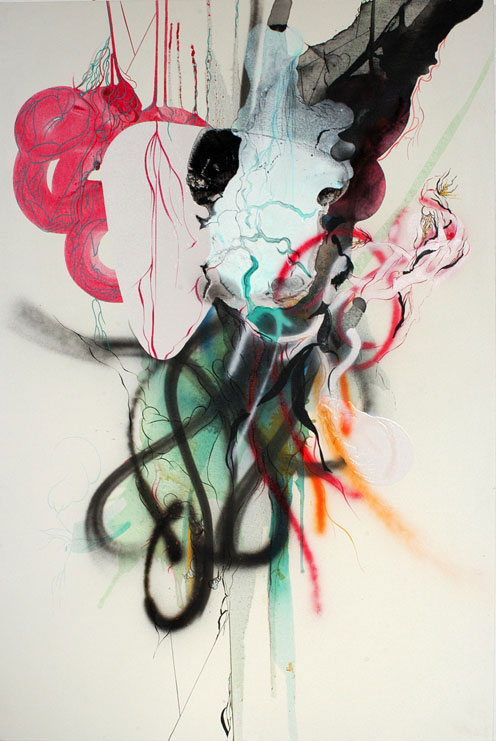Maggie Michael, Throw, 2006
MAGGIE MICHAEL
Throw, 2006
Latex, ink, enamel, and oil on canvas
60 x 40 inches
Courtesy of the artist
CURRENTLY ON VIEW: Stamp 2nd Floor, Colony Lounge
Maggie Michael’s Throw is immediately striking. The painting comprises a clutter of intertwining colors, lines, and shapes. Red lines bleed into pink pools of color, black paint twists over pastel greens, and the piece as a whole has an airy quality even though it is made with a variety of paints, latex, and enamel. Certain streams of color extend to the edges of the canvas while others stop short or fade, creating a sense of weightlessness despite the dense materials used to create the piece. With further observation, the colors begin to look less like indistinguishable forms. The viewer identifies organs, animals, and other organic shapes. This contrast between ambiguous clusters of paint and palpably lifelike forms can be unsettling for the viewer, challenging her capacity to distinguish illusion and reality.
Michael’s abstraction appears to be influenced by the abstract expressionist movement of the 1940s and 1950s. Abstract expressionism was a radical artistic direction that took shape after World War II, celebrating rugged individualism and masculinity. Abstract expressionists embraced an ethos of dynamic, process-oriented work through which their materials—primarily thinned paint and raw canvas—would take precedence over the artist’s hand. Artists such as Jackson Pollock (1912–1956) and Willem de Kooning (1904–1997) were credited with creating purely nonrepresentational pieces on a monumental scale and breaking away from accepted conventions in technique and subject matter.
This movement clearly influences Michael’s painting, but she also controls her materials in an evocative way that resembles the work of abstract artist Eva Hesse (1936–1970), as well as artwork associated with the feminist movement in the 1970s. Michael’s calculated manipulation of her media results in a contemporary angle on abstract expressionism, leaving behind its masculine posturing.
Alexandra Saltz, UMD ‘16
Communication
Throw belongs to a group of paintings by Maggie Michael that explore the tension between destruction and repair, control and release. Using an array of action painting techniques (spray-painting, dripping, precision brushwork), Michael imbues her large-scale paintings with movement and emotion. Their textured forms vacillate, suggesting biomorphic shapes such as veins and ventricles tangled in devices of communication such as illustration graphics and graffiti tags. Michael’s works are energetic and unpredictable and invite viewers to interpret them through their own experiences. According to the artist, “Whatever I think of, no matter what it could be, will be made to work together. Anything can be resolved. It is just a matter of how you approach it.”
Stamp Gallery, 2016

